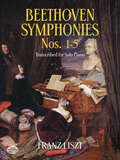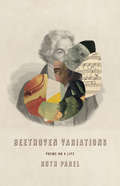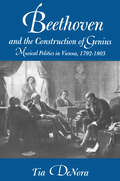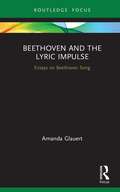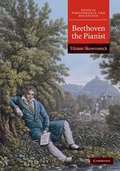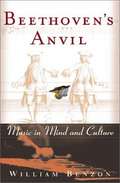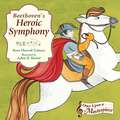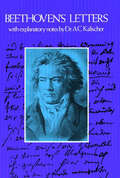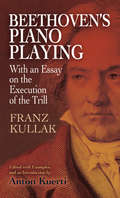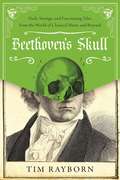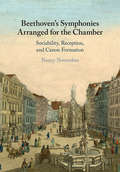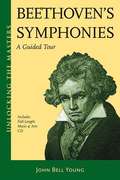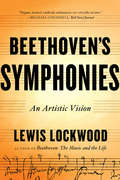- Table View
- List View
Beethoven Symphonies Nos. 6-9 Transcribed for Solo Piano (Dover Classical Piano Music)
by Franz LisztSecond volume in a Dover series of Liszt's piano transcriptions of Beethoven's nine symphonies includes Symphony No. 6 in F major, Op. 68, "Pastorale"; Symphony No. 7 in A major, Op. 92; Symphony No. 8 in F major, Op. 93; and Symphony No. 9 in D minor, Op. 125, "Choral." Also contains Liszt's handwritten French preface to his transcriptions and an English translation, plus an introduction by Dr. Alan Walker, author of the definitive Liszt biography.
Beethoven Variations: Poems on a Life
by Ruth PadelA fascinating poetic journey into the mind and heart of a musical genius, from the author of the celebrated Darwin: A Life in PoemsRuth Padel's new sequence of poems, in four movements, is a personal voyage through the life and legend of one of the world's greatest composers. She uncovers the man behind the music, charting his private thoughts and feelings through letters, diaries, sketchbooks, and the conversation books he used as his hearing declined. She gives us Beethoven as a battered four-year-old, weeping at the clavier; the young virtuoso pianist agonized by his encroaching deafness; the passionate, heartbroken lover; the clumsy eccentric making coffee with exactly sixty beans. Padel's quest takes her into the heart of Europe and back to her own musical childhood: Her great-grandfather, who studied in Leipzig with a pupil of Beethoven's, became a concert pianist before migrating to Britain; her parents met making music; and Padel grew up playing the viola, Beethoven's instrument as a child. Her book is a poet and string player's intimate connection across the centuries with an artist who, though increasingly isolated, ended even his most harrowing works on a note of hope.
Beethoven and Greco-Roman Antiquity
by Jos van ZandenLudwig van Beethoven had a life beyond music. He considered it his duty to spend leisure-time improving his Bildung (sophistication). To this end he familiarised himself with tangible manifestations of Greco-Roman antiquity, for he perceived these cultures and their representatives as examples of intellectual, moral, and artistic perfection. He consumed such writers as Homer, Plutarch, Horace, Tacitus, Euripides, and Greek poets. These texts were morally uplifting for him, and advantageous for building character. They now hold a key to Beethoven’s ideal of a steadfast, austere, and Stoic outlook, necessary for a ‘great man’ to carry out his duties. Jos van der Zanden demonstrates that Beethoven’s engagement with Greco-Roman culture was deep and ongoing, and that it ventured beyond the non-committal. Drawing on a comprehensive investigation of primary sources (letters, conversation books, diaries, recollections of contemporaries) he examines what Beethoven knew of such topics like history, art, politics, and philosophy of antiquity. The book presents new information on the composer’s republicanism, his familiarity with the works of Plato, his admiration of the elderly Brutus, his plan to utilize ‘unresolved dissonances’ in an unknown piece of music, and his decision to subscribe to a book about ancient Greek poetry. A hitherto unknown vocal piece based on lines by Euripides is revealed. The study concludes with a comprehensive survey of all compositions and sketches by Beethoven based on Greco-Roman subjects.
Beethoven and His World (The Bard Music Festival #48)
by Scott Burnham Michael P. SteinbergFew composers even begin to approach Beethoven's pervasive presence in modern Western culture, from the concert hall to the comic strip. Edited by a cultural historian and a music theorist, Beethoven and His World gathers eminent scholars from several disciplines who collectively speak to the range of Beethoven's importance and of our perennial fascination with him. The contributors address Beethoven's musical works and their cultural contexts. Reinhold Brinkmann explores the post-revolutionary context of Beethoven's "Eroica" Symphony, while Lewis Lockwood establishes a typology of heroism in works like Fidelio. Elaine Sisman, Nicholas Marston, and Glenn Stanley discuss issues of temporality, memory, and voice in works at the threshold of Beethoven's late style, such as An die Ferne Geliebte, the Cello Sonata op. 102, no. 1, and the somewhat later Piano Sonata op. 109. Peering behind the scenes into Beethoven's workshop, Tilman Skowroneck explains how the young Beethoven chose his pianos, and William Kinderman shows Beethoven in the process of sketching and revising his compositions. The volume concludes with four essays engaging the broader question of reception of Beethoven's impact on his world and ours. Christopher Gibbs' study of Beethoven's funeral and its aftermath features documentary material appearing in English for the first time; art historian Alessandra Comini offers an illustrated discussion of Beethoven's ubiquitous and iconic frown; Sanna Pederson takes up the theme of masculinity in critical representations of Beethoven; and Leon Botstein examines the aesthetics and politics of hearing extramusical narratives and plots in Beethoven's music. Bringing together varied and fresh approaches to the West's most celebrated composer, this collection of essays provides music lovers with an enriched understanding of Beethoven--as man, musician, and phenomenon.
Beethoven and the Construction of Genius: Musical Politics in Vienna, 1792-1803
by Tia DeNoraIn this provocative account Tia DeNora reconceptualizes the notion of genius by placing the life and career of Ludwig van Beethoven in its social context. She explores the changing musical world of late eighteenth-century Vienna and follows the activities of the small circle of aristocratic patrons who paved the way for the composer's success.DeNora reconstructs the development of Beethoven's reputation as she recreates Vienna's robust musical scene through contemporary accounts, letters, magazines, and myths—a colorful picture of changing times. She explores the ways Beethoven was seen by his contemporaries and the image crafted by his supporters. Comparing Beethoven to contemporary rivals now largely forgotten, DeNora reveals a figure musically innovative and complex, as well as a keen self-promoter who adroitly managed his own celebrity.DeNora contends that the recognition Beethoven received was as much a social achievement as it was the result of his personal gifts. In contemplating the political and social implications of culture, DeNora casts many aspects of Beethoven's biography in a new and different light, enriching our understanding of his success as a performer and composer.
Beethoven and the Lyric Impulse: Essays on Beethoven Song (Routledge Voice Studies)
by Amanda GlauertAmanda Glauert revisits Beethoven’s songs and studies his profound engagement with the aesthetics of the poets he was setting, particularly those of Herder and Goethe. The book offers readers a rich exploration of the poetical and philosophical context in which Beethoven found himself when composing songs. It also offers detailed commentaries on possible responses to specific songs, responses designed to open up new ways for performing, hearing and appreciating this provocative song repertoire. This study will be of great interest to researchers of Beethoven; German song; aesthetics of words and music.
Beethoven for Kids: His Life and Music with 21 Activities
by Helen BauerLudwig van Beethoven, one of the most influential composers of all time, is brought vividly to life and made relevant to today's young musicians in Beethoven for Kids. Children will learn about Beethoven's troubled childhood and family life, early gift and passion for music, volatile personality, championing of equality and freedom, and persistence in his work despite increasing hearing loss. The great musicians, thinkers, and movements of Beethoven's time, from Mozart and Haydn to the bold new ideas of the Enlightenment, are presented and their profound effect on the composer's life and music explained. Twenty-one engaging activities, including singing musical variations, dancing a Viennese waltz, creating an operatic diorama, and making a model eardrum, illuminate Beethoven's life, times, and work. A time line, a glossary, online resources, and recordings and reading lists for further listening and study round out this comprehensive resource.
Beethoven for a Later Age: Living with the String Quartets
by Edward Dusinberre&“A richly detailed portrayal of the intimate workings of a great string quartet . . . as revealed to us through the recollections of its first violinist.&”—Philip Roth Edward Dusinberre, first violinist of the renowned Takács Quartet, offers a rare peek inside the workings of his ensemble, while providing an insightful history of Beethoven&’s sixteen string quartets and their performance. Founded in Hungary in 1975 and now based in Boulder, Colorado, the Takács is one of the world&’s preeminent string quartets, and performances of Beethoven have been at the center of their work together for over forty years. Using the history of both the Takács Quartet and the Beethoven quartets as a foundation, Beethoven for a Later Age provides a backstage look at the daily life of a quartet, showing the necessary creative tension between individual and group and how four people can at the same time forge a lasting artistic connection and enjoy making music together over decades. In an accessible style, suitable for novices and chamber music enthusiasts alike, Dusinberre illuminates the variety and contradictions of Beethoven&’s quartets, which were composed against the turbulent backdrop of the Napoleonic Wars and their aftermath, and he brings the technical aspects of the music to life. &“We are given intimate insight into the almost impossible-to-describe musical process of rehearsal and performance, the artistic and human interaction that links these modern musicians with their forebears and Beethoven himself.&”—Garrick Ohlsson, pianist &“This singular memoir . . . will be something between informative and revelatory to readers from musicians to music lovers.&”—Jan Swafford, author of Beethoven: Anguish and Triumph
Beethoven in Russia: Music and Politics
by Frederick W. SkinnerHow did Ludwig van Beethoven help overthrow a tsarist regime? With the establishment of the Russian Musical Society and its affiliated branches throughout the empire, Beethoven's music reached substantially larger audiences at a time of increasing political instability. In addition, leading music critics of the regime began hearing Beethoven's dramatic works as nothing less than a call to revolution. Beethoven in Russia deftly explores the interface between music and politics in Russia by examining the reception of Beethoven's works from the late 18th century to the present. In part 1, Frederick W. Skinner's clear and sweeping review examines the role of Beethoven's more dramatic works in the revolutionary struggle that culminated in the Revolution of 1917. In part 2, Skinner reveals how this same power was again harnessed to promote Stalin's campaign of rapid industrialization. The appropriation of Beethoven and his music to serve the interests of the state remained the hallmark of Soviet Beethoven reception until the end of communist rule. With interdisciplinary appeal in the areas of history, music, literature, and political thought, Beethoven in Russia shows how Beethoven's music served as a call to action for citizens and weaponized state propaganda in the great political struggles that shaped modern Russian history.
Beethoven in the Bunker: Musicians Under the Nazi Regime
by Fred BrouwersThis compelling survey examines the remarkable relationship between the Nazis and classical music through the stories of musicians, composers, and conductors across the political spectrum.May 1945. A Soviet military patrol searches Hitler&’s secret bunker in Berlin. They find bodies, documents, jewelry, paintings—and also an extensive collection of 78 rpm records. It comes as no surprise that this collection includes work by Beethoven, Wagner, and Bruckner. The same goes for a procession of other giants promoted by the Nazi regime: &“It seems as if the Nazis put a steel helmet on Mozart, girded Schubert with a saber, and wrapped barbed wire around Johann Strauss&’s neck,&” composer Robert Stolz once said. But how is it possible that Hitler&’s favorites also included &“forbidden&” Jewish and Russian composers and performers? While Hitler sat secretly enjoying previously recorded music in his bunker, musicians made of flesh and blood were denied a means of making a living. They died in concentration camps or in other war-related circumstances. They survived but ended up in psychiatric care; they managed to flee just in time; they sided with the regime—out of conviction or coercion—or they joined the resistance. From fiery conductor Arturo Toscanini, who defied Mussolini and Hitler, to opportunistic composer Richard Strauss and antisemitic pianist Elly Ney, who collaborated with the Third Reich to varying extents and for different reasons, Fred Brouwers profiles the complex figures of this extraordinarily fascinating chapter in music history.
Beethoven or Bust: A Practical Guide to Understanding and Listening to Great Music
by David HurwitzA book intended for those people who have a budding curiosity in music of all types, but who don't have the slightest idea of where to begin.
Beethoven the Pianist
by Tilman SkowroneckThe widely held belief that Beethoven was a rough pianist, impatient with his instruments, is not altogether accurate: it is influenced by anecdotes dating from when deafness had begun to impair his playing. Presenting a new, detailed biography of Beethoven's formative years, this book reviews the composer's early career, outlining how he was influenced by teachers, theorists and instruments. Skowroneck describes the development and decline of Beethoven's pianism, and pays special attention to early pianos, their construction and their importance for Beethoven and the modern pianist. The book also includes new discussions of legato and Beethoven's trills, and a complete annotated review of eyewitnesses' reports about his playing. Skowroneck presents a revised picture of Beethoven which traces his development from an impetuous young musician into a virtuoso in command of many musical resources.
Beethoven's Anvil: Music in Mind and Culture
by William BenzonA cognitive scientists and co-founder of the Afro-Eurasian Connection music ensemble, Benzon argues that music connects people not so much to the physical world as to the social world that comes into being through music. It is comprised of groups ranging from two to billions that become a community by dancing and singing. Despite the title, he looks to the future rather than the past, describing building block for communities.
Beethoven's Eroica: The First Great Romantic Symphony
by James Hamilton-PatersonAn ode to Beethoven's revolutionary masterpiece, his Third Symphony In 1805, the world of music was startled by an avant-garde and explosive new work. Intellectually and emotionally, Beethoven's Third Symphony, the "Eroica," rudely broke the mold of the Viennese Classical symphony and revealed a powerful new expressiveness, both personal and societal. Even the whiff of actual political revolution was woven into the work-it was originally inscribed to Napoleon Bonaparte, a dangerous hero for a composer dependent on conservative royal patronage. With the first two stunning chords of the "Eroica," classical music was transformed.In Beethoven's Eroica, James Hamilton-Paterson reconstructs this great moment in Western culture, the shock of the music and the symphony's long afterlife.
Beethoven's French Piano: A Tale of Ambition and Frustration
by Tom BeghinUsing a replica of Beethoven’s Erard piano, scholar and performer Tom Beghin launches a striking reinterpretation of a key period of Beethoven’s work. In 1803 Beethoven acquired a French piano from the Erard Frères workshop in Paris. The composer was “so enchanted with it,” one visitor reported, “that he regards all the pianos made here as rubbish by comparison.” While Beethoven loved its sound, the touch of the French keyboard was much heavier than that of the Viennese pianos he had been used to. Hoping to overcome this drawback, he commissioned a local technician to undertake a series of revisions, with ultimately disappointing results. Beethoven set aside the Erard piano for good in 1810. Beethoven’s French Piano returns the reader to this period of Beethoven’s enthusiasm for all things French. What traces of the Erard’s presence can be found in piano sonatas like his “Waldstein” and “Appassionata”? To answer this question, Tom Beghin worked with a team of historians and musicians to commission the making of an accurate replica of the Erard piano. As both a scholar and a recording artist, Beghin is uniquely positioned to guide us through this key period of Beethoven’s work. Whether buried in archives, investigating the output of the French pianists who so fascinated Beethoven, or seated at the keyboard of his Erard, Beghin thinks and feels his way into the mind of the composer, bringing startling new insights into some of the best-known piano compositions of all time.
Beethoven's French Piano: A Tale of Ambition and Frustration
by Tom BeghinUsing a replica of Beethoven’s Erard piano, scholar and performer Tom Beghin launches a striking reinterpretation of a key period of Beethoven’s work. In 1803 Beethoven acquired a French piano from the Erard Frères workshop in Paris. The composer was “so enchanted with it,” one visitor reported, “that he regards all the pianos made here as rubbish by comparison.” While Beethoven loved its sound, the touch of the French keyboard was much heavier than that of the Viennese pianos he had been used to. Hoping to overcome this drawback, he commissioned a local technician to undertake a series of revisions, with ultimately disappointing results. Beethoven set aside the Erard piano for good in 1810. Beethoven’s French Piano returns the reader to this period of Beethoven’s enthusiasm for all things French. What traces of the Erard’s presence can be found in piano sonatas like his “Waldstein” and “Appassionata”? To answer this question, Tom Beghin worked with a team of historians and musicians to commission the making of an accurate replica of the Erard piano. As both a scholar and a recording artist, Beghin is uniquely positioned to guide us through this key period of Beethoven’s work. Whether buried in archives, investigating the output of the French pianists who so fascinated Beethoven, or seated at the keyboard of his Erard, Beghin thinks and feels his way into the mind of the composer, bringing startling new insights into some of the best-known piano compositions of all time.
Beethoven's Hair: An Extraordinary Historical Odyssey and a Scientific Mystery Solved
by Russell MartinReaders will follow the strange, yet true, journey made by a lock of Ludwig van Beethovens hair from the time it was clipped from the composers head on his deathbed in Germany in 1827 to a World War II refugee safe house in Denmark in 1943 to its eventual sale at auction in 1994. From this lock of hair, scientists were able to discover the cause of Beethovens death, a question that had long puzzled scientists and musicologists.
Beethoven's Heroic Symphony (Once Upon a Masterpiece #4)
by Anna Harwell CelenzaDiscover the little-known story of Beethoven's beloved masterwork. As the best pianist in Vienna, Ludwig van Beethoven had everything: talent, money, fame. But he also had a terrible secret. He was slowly going deaf. Though his hearing deserted him, the maestro never lost his music. Seeking inspiration for his compositions, Beethoven hit upon Napoleon Bonaparte, then considered a liberator and a folk hero. Soon after Beethoven completed the work, Napoleon declared himself Emperor of France; betrayed and enraged, Beethoven tore his copy of the score to pieces. But his friend Ferdinand rescued a copy, and in time, Beethoven renamed it Eroica: the Heroic Symphony, dedicated to hero in each and every one of us.
Beethoven's Letters
by Ludwig Van BeethovenLudwig van Beethoven (1770-1827), the protagonist of freedom for music, disentangled music from the control of the ruling class. In publishing his music and writing for the rising classes, Beethoven claimed freedom and expressed the emotions of the new rulers, the artists. The Eroica, Fidelio, and the piano works express the emotions of the new rulers -- the intense love, the need for companionship of people, the forces that conspired to defeat the artist, and the strength and superiority of the artist in overcoming the weaknesses. The letters of Beethoven are the principal nonmusical expression of his personality in its relationship with the world of his time.In what he called the "dry letters of the alphabet," Beethoven depicted his fears, his loves, and his friendly relations: his fears of deafness and of corrupted texts by pirating printers; his loves, Bettina Brentano and Giulietta Guicciardi; and his friendly relations with Baron Zmeskall, Frau Nannette Streicher, and the music publishers Steiner and Company. He praises the poetry of Goethe and Schiller but condemns Goethe for his obeisance toward royalty. He solicits help during his perpetual trouble with his health and with his servants. He castigates publishers, sets prices for his works, and calculates letters of dedication. He expresses his love for his nephew, Carl, but documents the trouble that Carl was causing him by taking up his precious time. And although Beethoven liked to decorate the letters with musical openings and closings and an occasional song to the receiver, he increasingly signed his letters, "In haste."The 457 letters collected here are the most important of the letters of the spirit that was to shape and move a century. Explanatory notes comment upon works, on persons mentioned, and on the puns of which Beethoven was fond. The letters chronicle his business, his needs, his humor and bitterness, and his philosophy. They will give many insights into Beethoven's methods, his influences, his moods, and the conditions under which the master worked.
Beethoven's Piano Playing: With an Essay on the Execution of the Trill
by Anton Kuerti Franz KullakOriginally written as an introduction to a critical edition of Beethoven's piano concertos, this informative performance guide is the work of an accomplished pianist, composer, and conductor. Franz Kullak presents more than 100 annotated and analyzed musical examples along with biographical information about the composer and general rules for the performance of the concertos. In addition, a separate essay offers pointers on the proper execution of the trill. Suitable for intermediate- and advanced-level pianists, this volume is newly edited and supplemented with additional examples by celebrated concert pianist and composer Anton Kuerti, who provides an informative Introduction with musical examples.
Beethoven's Piano Sonatas: A Short Companion
by Charles RosenBeethoven’s piano sonatas form one of the most important collections of works in the whole history of music. Spanning several decades of his life as a composer, the sonatas soon came to be seen as the first body of substantial serious works for piano suited to performance in large concert halls seating hundreds of people.In this comprehensive and authoritative guide, Charles Rosen places the works in context and provides an understanding of the formal principles involved in interpreting and performing this unique repertoire, covering such aspects as sonata form, phrasing, and tempo, as well as the use of pedal and trills. In the second part of his book, he looks at the sonatas individually, from the earliest works of the 1790s through the sonatas of Beethoven’s youthful popularity of the early 1800s, the subsequent years of mastery, the years of stress (1812†“1817), and the last three sonatas of the 1820s.Composed as much for private music-making as public recital, Beethoven’s sonatas have long formed a bridge between the worlds of the salon and the concert hall. For today’s audience, Rosen has written a guide that brings out the gravity, passion, and humor of these works and will enrich the appreciation of a wide range of readers, whether listeners, amateur musicians, or professional pianists.The book includes a CD of Rosen performing extracts from several of the sonatas, illustrating points made in the text.
Beethoven's Skull: Dark, Strange, and Fascinating Tales from the World of Classical Music and Beyond
by Tim RaybornBeethoven's Skull is an unusual and often humorous survey of the many strange happenings in the history of Western classical music. Proving that good music and shocking tabloid-style stories make excellent bedfellows, it presents tales of revenge, murder, curious accidents, and strange fates that span more than two thousand years. Highlights include: A cursed song that kills those who hear it A composer who lovingly cradles the head of Beethoven's corpse when his remains are exhumed half a century after his death A fifteenth-century German poet who sings of the real-life Dracula A dream of the devil that inspires a virtuoso violin pieceUnlike many music books that begin their histories with the seventeenth or eighteenth centuries, Beethoven's Skull takes the reader back to the world of ancient Greece and Rome, progressing through the Middle Ages and all the way into the twentieth century. It also looks at myths and legends, superstitions, and musical mysteries, detailing the ways that musicians and their peers have been rather horrible to one another over the centuries.
Beethoven's Symphonies Arranged for the Chamber: Sociability, Reception, and Canon Formation
by Nancy NovemberEarly nineteenth-century composers, publishers and writers evolved influential ideals of Beethoven's symphonies as untouchable masterpieces. Meanwhile, many and various arrangements of symphonies, principally for amateur performers, supported diverse and 'hands-on' cultivation of the same works. Now mostly forgotten, these arrangements served a vital function in nineteenth-century musical life, extending works' meanings and reach, especially to women in the home. This book places domestic music-making back into the history of the classical symphony. It investigates a largely untapped wealth of early nineteenth-century arrangements of symphonies by Beethoven - for piano, string quartet, mixed quintet and other ensembles. The study focuses on three key agents in the nineteenth-century culture of musical arrangement: arrangers, publishers and performers. It investigates significant functions of those musical arrangements in the era: sociability, reception and canon formation. The volume also explores how conceptions of Beethoven's symphonies, and their arrangement, changed across the era with changing conception of musical works.
Beethoven's Symphonies: A Guided Tour
by John Bell YoungThe latest release in this value rich book/CD series brings us the great German composer who bridged the classical and romantic eras. In Beethoven's Symphonies: A Guided Tour, readers are treated to a detailed nuts-and-bolts description in easy-to-understand English of each of the famous nine Beethoven symphonies. This book is perfect for anyone who wants to read, listen, and learn more about Beethoven (1770-1827), and discover how this musical genius changed the face of orchestral music forever.
Beethoven's Symphonies: An Artistic Vision
by Lewis LockwoodAn exploration of the unswerving artistic vision underlying Beethoven’s symphonies, from one of the world’s leading scholars of the composer’s works. More than any other composer, Beethoven left to posterity a vast body of material that documents the early stages of almost everything he wrote. From this trove of sketchbooks, Lewis Lockwood draws us into the composer’s mind, unveiling a creative process of astonishing scope and originality. For musicians and nonmusicians alike, Beethoven’s symphonies stand at the summit of artistic achievement, loved today as they were two hundred years ago for their emotional cogency, variety, and unprecedented individuality. Beethoven labored to complete nine of them over his lifetime—a quarter of Mozart’s output and a tenth of Haydn’s—yet no musical works are more iconic, more indelibly stamped on the memory of anyone who has heard them. They are the products of an imagination that drove the composer to build out of the highest musical traditions of the past something startlingly new. Lockwood brings to bear a long career of studying the surviving sources that yield insight into Beethoven’s creative work, including concept sketches for symphonies that were never finished. From these, Lockwood offers fascinating revelations into the historical and biographical circumstances in which the symphonies were composed. In this compelling story of Beethoven’s singular ambition, Lockwood introduces readers to the symphonies as individual artworks, broadly tracing their genesis against the backdrop of political upheavals, concert life, and their relationship to his major works in other genres. From the first symphonies, written during his emerging deafness, to the monumental Ninth, Lockwood brings to life Beethoven’s lifelong passion to compose works of unsurpassed beauty.
